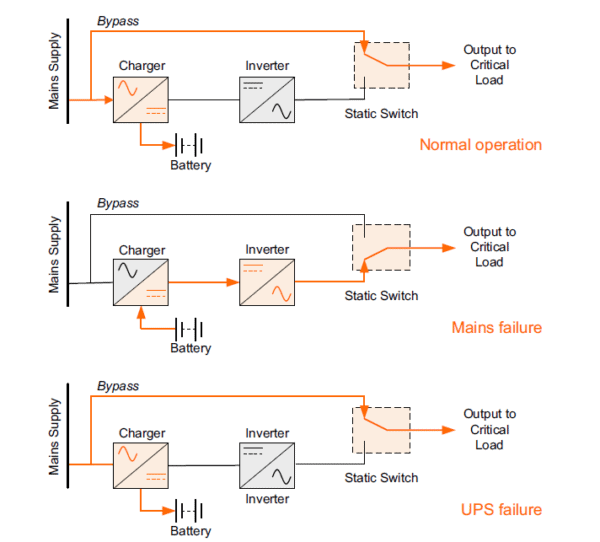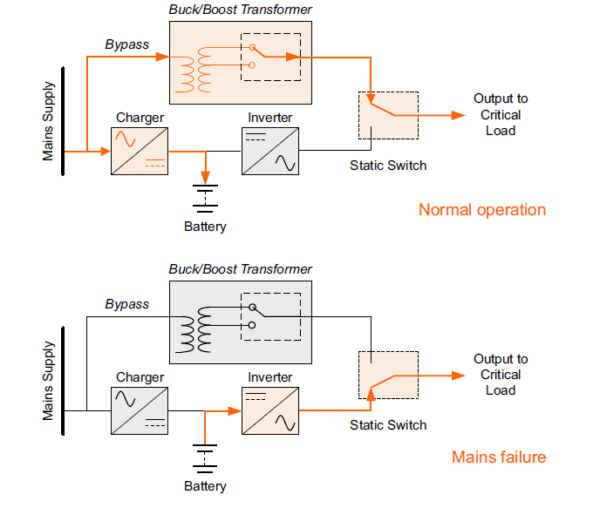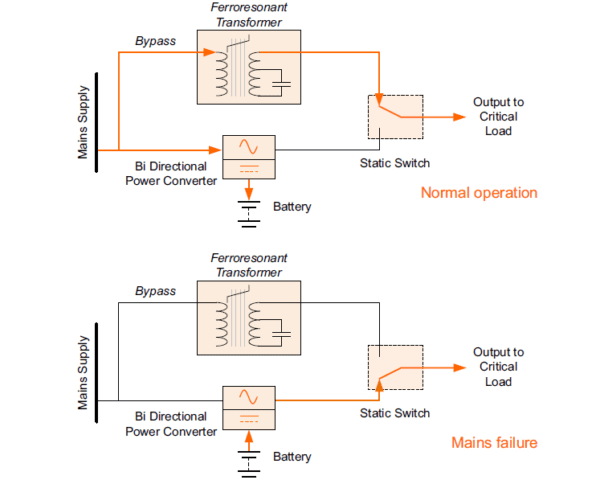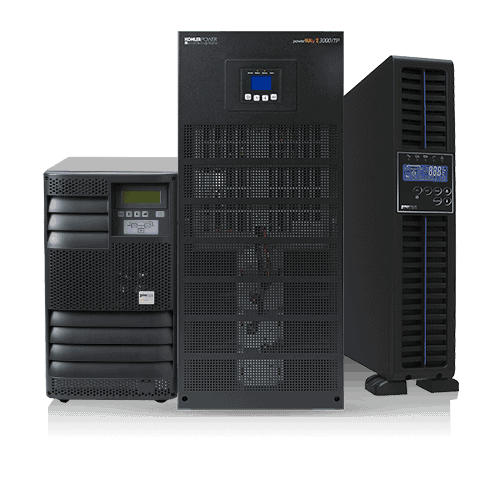When it comes to uninterruptible power supplies, there are a range of solutions to choose from. One of the most common questions that we often get asked, is what the difference is between online, offline and line-interactive UPSs and which one a particular business needs.
The UPSs used in most applications today use solid-state technology to manage their power control and communications functions, and are therefore described as static UPS systems.
Before static UPS systems a rotary system was typically used. This system used flywheels to convert and store energy, before converting it back into electrical energy when needed. Nowadays, static systems have largely superseded rotary systems due to their reduced size and weight, their increased efficiency and the high cost and complexity of maintaining a rotary system.
Types of Static UPS Systems
Static UPS systems are available in various power topologies. Generally speaking, there are three main operational design architectures for UPS units and modules, which are offline, online and line-interactive. All are designed around a stored energy source – usually a lead/acid battery – that accumulates power from the electrical mains supply during normal power availability, and then dispenses it to the critical load during mains supply disturbances or blackouts. This means that they use common building blocks; a rectifier/charger to convert incoming AC into a DC charging current for the battery; an inverter to generate AC current for the critical load; and a static switch to connect either the inverter output or the mains supply to the critical load as circumstances demand.
These components interact in protecting the load within either an online, offline or line-interactive topology. As we shall see, these modes represent different trade-offs between capital, operating costs, and levels of protection. It is up to each user to decide which approach is most appropriate to the needs of their communications and data processing load, and the business that it supports.
Offline UPS systems
Offline uninterruptible power supply systems are so-called because the load is fed directly from the raw mains during normal operation, rather than from the inverter output. To that extent, the energy storage components – charger, battery and inverter – are offline as far as the load is concerned, although the charger and battery remain connected to the mains to ensure the battery is always fully charged.
As low voltage is the most common cause of load transfer, an offline UPS system works by immediately connecting the inverter to the critical load if the bypass voltage falls below or exceeds preset limits. During this changeover there is an inevitable break in power to the load of typically 2 to 10 ms. In practice, however, most loads can ride through this period without any problems.
Most offline models include a degree of spike suppression and radio frequency interference filtering in their bypass circuits to ensure that any mains disturbances during acceptable bypass voltage ranges are smoothed through, however this risk is not 100% eliminated.
The advantages of offline UPS systems are that they are cheaper to purchase, and without the charger and inverter being permanently on load, they are more economical and energy efficient.
As the inverter runs from battery power once the load is transferred, the inverter can only run until the battery voltage falls to its end-of-discharge level unless another bypass supply is restored.
Summary of an offline UPS system
These key points might influence the decision in using an offline system:
- Output waveform is not closely regulated under normal operations
- 2 to 10 ms. load break when transferring the load between inverter and bypass
- Lower capital costs than an online system because of the lower rated components
- Lower running cost as the charger and inverter are not permanently on load
Online UPS systems
By contrast, online uninterruptible power supplies use a rectifier, or charger block instead of a battery charger. This means that the online system draws power through the power conditioning and charging components during normal operation, so the load always receives conditioned power rather than raw mains.
Online UPSs are often called ‘double conversion’ types because incoming power is converted once to DC, for the battery, and then back to AC before reaching the load – which is therefore well-insulated from the mains. Additionally, there is no power interruption if the battery is called upon to take over from the mains. This offers the greatest degree of critical supply integrity as the load is supplied with processed power at all times.
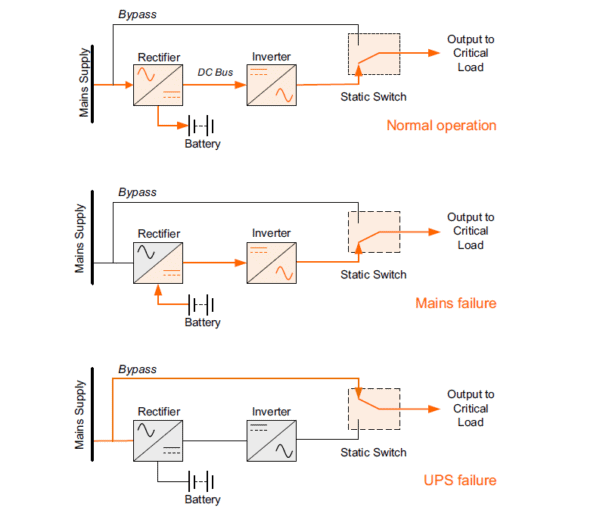
If the input supply goes outside a pre-set voltage range or suffers a total failure, the inverter will continue to operate from the battery power, meaning the event is totally transparent to the load as no transfer operation is involved.
If the mains is not restored before the battery reaches its end-of-discharge voltage, the inverter shuts down. One way to overcome this is to include a standby generator in the system as an alternative UPS input supply source.
Online UPS Summary
An Online UPS output is independent of voltage and frequency variations of the mains.
- Offers the highest level of critical load protection as the load is supplied with closely regulated power at all times
- Has a load break of less than 5ms when transferring between inverter and bypass
- Is totally transparent to the load in the case of a mains failure
- Is the most expensive capital cost of UPS systems
- Has a higher running cost than other types of system, as the rectifier and inverter are permanently on load.
Line-interactive UPS systems
A line interactive uninterruptible power supply is a hybrid device that adds some form of voltage regulation feature in the bypass line to conventional off-line UPS designs.
Like off-line models, a line interactive UPS supplies the critical load through the bypass line and transfers it to the inverter in the event of a bypass supply failure. The battery, charger and inverter power blocks are utilised in the same manner as in an offline system but the added regulation circuits mean that the load is transferred to the battery-fed inverter supply less often. This means that this type of system is slightly more efficient in running costs and battery wear than a basic offline UPS system.
Line-interactive UPS systems typically use either a ferro-resonant transformer or a buck-boost transformer implementation.
A buck-boost transformer design
A buck-boost transformer controls the output voltage within the required output voltage limits, by using secondary windings and relays to step-up or step-down the bypass voltage. This means that a wider variation of bypass voltage exists before the output voltage reaches its limits and initiates a load transfer to inverter.
Although the output voltage is maintained within a preferred window using this method, it should be noted that buck-boost switching unavoidably leads to a degree of step voltage changes as tap changes take place.
Ferroresonant transformer design
This is similar to the buck/boost system but the transformer is replaced with a ferroresonant transformer. This transformer provides voltage regulation and power conditioning for disturbances such as electrical line noise. The stored energy in the ferroresonant transformer effectively turns the system into a true online system as it is sufficient enough to ride through a bypass supply break of one or two cycles, meaning that the load is effectively transferred without a power break.
Both approaches reduce the frequency of transfers to battery, slightly improving efficiency and reducing battery ‘wear’. Ferroresonant designs also offer power conditioning and tight voltage regulation, as well as an energy store that can maintain uninterrupted power supply output while the inverter switches on.
Line-interactive UPS Summary
A line interactive UPS has the same advantages and disadvantages as an offline UPS system, with the exception that a line-interactive system provides a degree of automatic voltage regulation that an offline UPS does not.
The following key points might influence the choice of line-interactive systems:
- A ferroresonant line-interactive UPS is generally larger, heavier and more expensive than a buck/boost UPS
- A ferroresonant line-interactive UPS is also less efficient than a buck/boost system as it has higher running costs and generates more heat
- The output voltage of a ferroresonant UPS is much more closely regulated than a buck/boost system and does not present step voltage changes that a buck/boost system has
- There is less degradation to battery life in a ferroresonant UPS as it switches to inverter operation less frequently than a buck/boost system
- As the ferroresonant UPS transformer is tuned to operate at the line frequency, it is not suitable to use with a possibly unstable bypass supply, such as a generator
- The stored energy in a ferroresonant UPS is sufficient enough to ride through minor outages and bypass/inverter load transfer operation
Summary
The choice between an online, offline or line interactive UPS depends on the business needs and requirements. Most users with highly critical loads will inevitably choose online UPS topology because of its ability to protect sensitive equipment and data from mains problems at all times. For many, this security far outweighs any extra cost consideration – especially as modern UPS hardware has become highly efficient in operation, significantly reducing excess operating costs.
For more information on our UPS systems please get in touch with our team.
We also run regular CPD Academies and events where we go into more detail on the different types of UPS systems available and areas to consider. Check out our list of upcoming events here.


